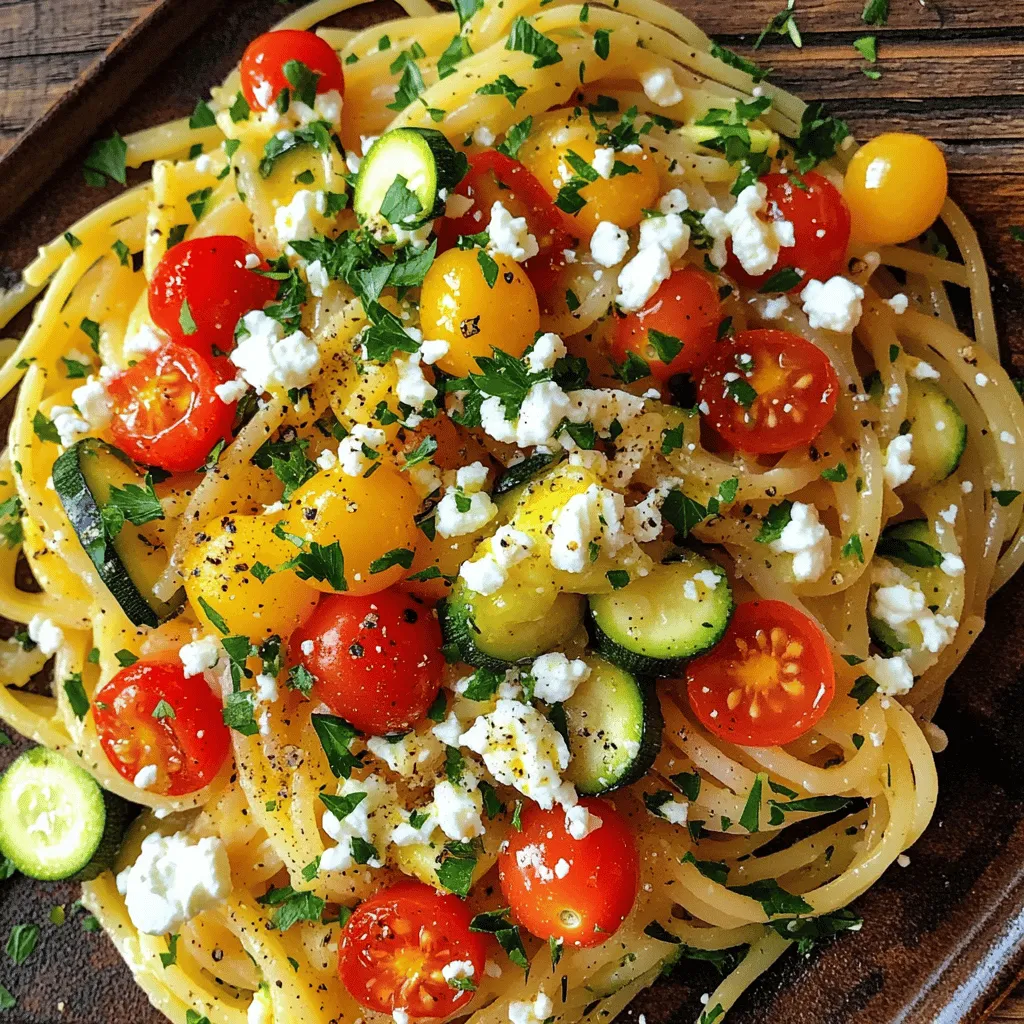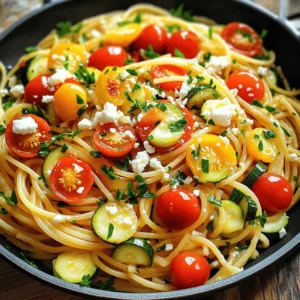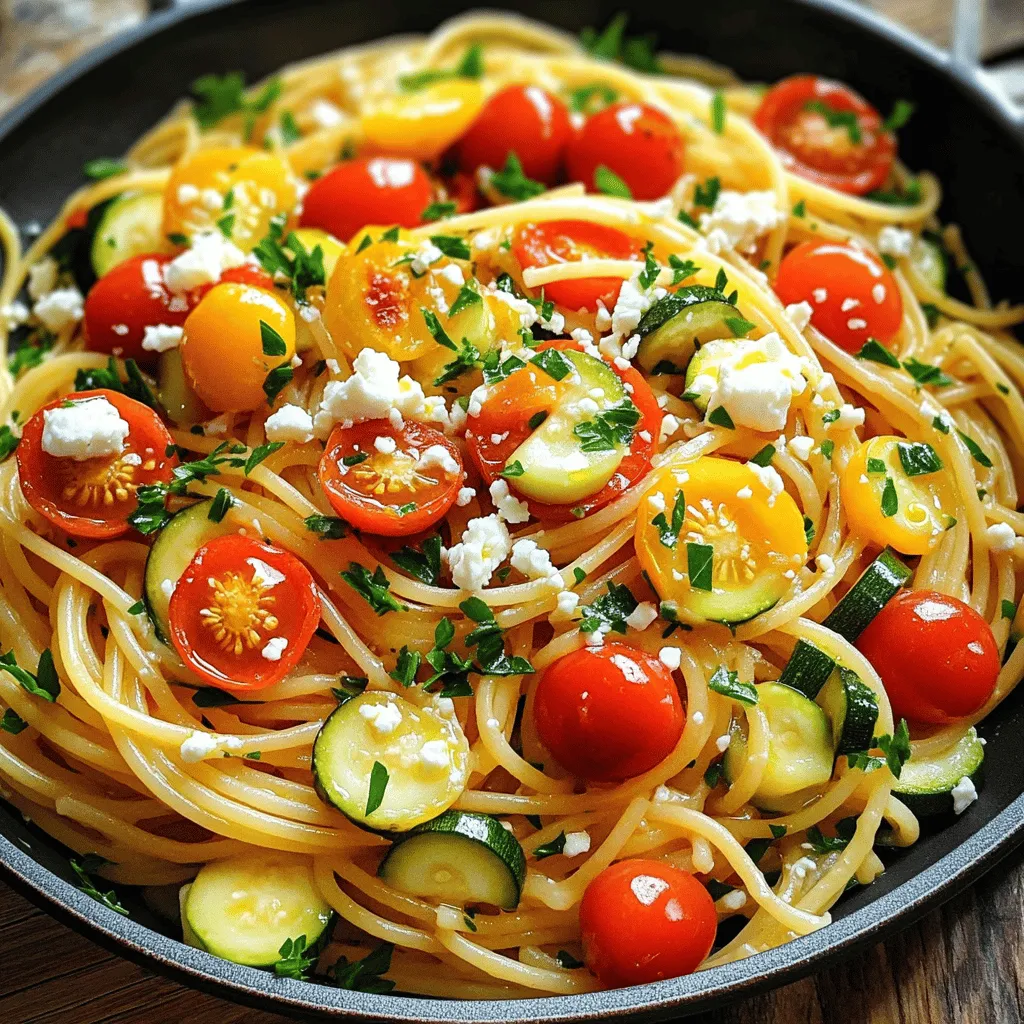Looking to spice up your dinner routine? Mediterranean Pasta is not just tasty—it’s quick and easy! In this guide, I’ll share a flavorful recipe that includes fresh, vibrant ingredients. You’ll learn essential tips on cooking, storage, and variations, helping you create a dish your family will love. Ready to impress your taste buds? Let’s dive into the world of Mediterranean flavors together!
Ingredients
Essential Ingredients for Mediterranean Pasta
To make Mediterranean pasta, you need key ingredients for great taste. Here is the list:
– 300g spaghetti or penne pasta
– 2 tablespoons olive oil
– 3 cloves garlic, minced
– 1 medium red bell pepper, diced
– 1 medium zucchini, diced
– 1 cup cherry tomatoes, halved
– 1 can (15oz) chickpeas, drained and rinsed
– 1 teaspoon dried oregano
– 1 teaspoon dried basil
– Salt and pepper to taste
– 1 cup feta cheese, crumbled
– Fresh parsley, chopped (for garnish)
– Juice of 1 lemon
These ingredients make a bright and tasty dish.
Optional Ingredients to Enhance Flavor
You can add other ingredients to give your Mediterranean pasta more flavor. Consider these options:
– Fresh spinach for added nutrients
– Kalamata olives for a briny kick
– Sun-dried tomatoes for a richer taste
– Capers for a zesty touch
– Pine nuts for a crunchy texture
Feel free to mix and match these extras to suit your taste.
Tips on Choosing Fresh Produce
Picking fresh produce is important for the best flavor. Here are some tips to help you:
– Choose firm tomatoes with vibrant color.
– Look for zucchinis that are small and shiny.
– Select bell peppers that are heavy for their size.
– Always smell the produce; fresh items have a strong scent.
– Buy seasonal vegetables for better taste and price.
Using fresh ingredients will elevate your Mediterranean pasta to the next level. For the complete recipe, refer to the Full Recipe section.
Step-by-Step Instructions
Detailed Cooking Method for Mediterranean Pasta
To make Mediterranean pasta, follow these steps closely. First, cook your pasta. Boil water in a large pot and add salt. Cook the pasta until it is al dente, which usually takes about 8-10 minutes. Drain the pasta, but remember to save ½ cup of the water.
Next, heat 2 tablespoons of olive oil in a large skillet over medium heat. Add 3 cloves of minced garlic and cook for 1-2 minutes until it smells nice. Then, add 1 medium diced red bell pepper and 1 medium diced zucchini to the skillet. Stir them for 5-7 minutes until they are soft.
Now, it is time to add 1 cup of halved cherry tomatoes and a can of drained chickpeas. Cook this mixture for another 3-4 minutes. You want the tomatoes to soften and give up their juice. After that, sprinkle in 1 teaspoon of dried oregano, 1 teaspoon of dried basil, and salt and pepper to taste. Mix everything together well.
Then, add the cooked pasta to the skillet. Pour in the reserved pasta water and juice from 1 lemon. Toss everything gently so that the pasta gets coated with the veggie mix. Finally, fold in 1 cup of crumbled feta cheese. Let it melt a bit into the warm pasta, and then remove it from the heat. Garnish with fresh chopped parsley before serving.
Common Mistakes to Avoid During Cooking
One common mistake is overcooking the pasta. Always check the package for timing and taste it before draining. Another mistake is not saving the pasta water. This water helps to create a nice sauce. Also, don’t forget to season your veggies well. It makes a big difference in flavor.
Avoid heating the skillet too high. Medium heat is best for cooking garlic without burning it. Lastly, folding the feta gently is key. You do not want it to crumble too much before serving.
How to Achieve the Best Texture
To get the best texture in your Mediterranean pasta, use fresh ingredients. Fresh veggies taste better and give a nice crunch. Make sure your pasta is cooked just right, so it doesn’t turn mushy. The reserved pasta water helps bind the sauce, so use it wisely.
When mixing everything, toss gently. This keeps the pasta intact and allows the flavors to blend well. If you want extra creaminess, let the feta melt slightly into the pasta. It adds a smooth texture that everyone will love.
Tips & Tricks
Time-Saving Cooking Techniques
To save time, use a large pot for boiling water. Start cooking the pasta while you chop the vegetables. This way, both will be ready at the same time. I often use a microwave to soften my garlic. Just crush it, place it in a bowl, and microwave for 20 seconds. It speeds up the cooking process.
How to Make it Extra Flavorful
To boost flavor, use fresh herbs instead of dried ones. Fresh basil and parsley add bright notes. A squeeze of lemon juice brightens everything up. You can also add a pinch of red pepper flakes for a kick. If you have time, let the veggies marinate in olive oil and spices before cooking. This enhances their taste.
Recommended Cooking Tools and Utensils
A sturdy pot for boiling pasta is key. Use a large skillet for sautéing veggies. A good knife makes cutting easier and faster. I love using a wooden spoon for mixing; it’s gentle on your pans. A microplane zester is great for getting zest from lemons. These tools make cooking more fun and efficient.
For the complete experience, check out the Full Recipe for Mediterranean Sun-Kissed Pasta.

Variations
Vegetarian and Vegan Alternatives
You can easily make this dish vegetarian or vegan. For a vegetarian option, just skip the feta cheese or use a plant-based feta. If you want a vegan dish, replace the feta with a nut-based cheese. You can also try adding more veggies like spinach or kale for extra nutrition.
Regional Mediterranean Influences
Mediterranean pasta varies by region. In Italy, you might add olives or capers for a salty kick. Spanish influences can bring in saffron or chorizo for warmth. Greek styles often include fresh herbs and lemon, enhancing the bright flavors in your dish.
Possible Additions and Substitutions
Feel free to mix and match ingredients in your pasta. Try adding cooked shrimp or grilled chicken for protein. You can substitute chickpeas with lentils or beans for a different texture. If you can’t find fresh herbs, dried versions work too, just use less. The key is to experiment and find your favorite blend. For the full recipe, check out the Mediterranean Sun-Kissed Pasta.
Storage Info
How to Properly Store Leftovers
To keep your Mediterranean pasta fresh, let it cool first. Once cooled, place it in an airtight container. This helps prevent any bacteria from growing. Store it in the fridge for up to three days. If you have extra sauce or veggies, store them separately. This keeps the pasta from getting soggy.
Best Practices for Reheating
When you’re ready to eat, you can reheat the pasta easily. Use the microwave or a skillet. If using a microwave, cover the dish to keep moisture in. Heat it in short bursts, stirring often. If using a skillet, add a splash of water or olive oil. This helps to revive the flavors. Heat on medium until warm, stirring frequently.
Freezing Options for Meal Prep
Freezing is a great way to save your pasta for later. First, let it cool completely. Then, divide it into portions and place in freezer bags. Remove as much air as possible to avoid freezer burn. You can freeze it for up to three months. When ready to eat, thaw it in the fridge overnight and reheat as mentioned before.
This method makes meal prep simple and tasty! For the full recipe and more details, check out the Mediterranean Sun-Kissed Pasta section.
FAQs
What is Mediterranean Pasta?
Mediterranean pasta is a dish that blends fresh veggies, herbs, and pasta. It often has flavors from Italy, Greece, and Spain. The main ingredients include pasta, olive oil, and colorful vegetables. This mix makes the dish tasty and healthy. I love using chickpeas for protein and feta cheese for creaminess. You can enjoy it warm or cold, making it a great meal for any season.
How can I make a gluten-free version?
To make a gluten-free version, use gluten-free pasta. Many stores sell options made from rice, corn, or quinoa. They cook similarly to regular pasta. Follow the cooking time on the package. When you sauté your veggies, make sure they are fresh and flavorful. You can still add chickpeas and feta to keep the dish hearty.
What are the health benefits of Mediterranean pasta?
Mediterranean pasta is packed with nutrients. The veggies provide vitamins and minerals. Chickpeas add fiber and protein, which help you feel full. Olive oil has healthy fats that are good for your heart. Feta cheese offers calcium for strong bones. Overall, this dish supports a balanced diet and promotes good health.
Can I use different pasta types for this recipe?
Yes, you can use different pasta types! Spaghetti and penne work well, but you can try others too. Farfalle or fusilli adds a fun twist. Just keep an eye on the cooking time. Each pasta type has its own texture, which can change the dish’s feel.
How long does it take to prepare Mediterranean Pasta?
Preparing Mediterranean pasta takes about 30 minutes. You spend 10 minutes getting your ingredients ready and 20 minutes cooking. This quick time makes it perfect for busy nights. You can whip up a tasty meal without spending hours in the kitchen. For the full recipe, check out the details above!
Mediterranean pasta is simple, tasty, and healthy. We covered the key ingredients and cooking steps. You learned how to pick fresh produce and avoid common mistakes. I shared tips to save time and enhance flavor. We also explored different variations and storage methods.
Now, you have all you need to make your dish shine. Enjoy your cooking and savor each bite!

